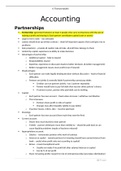Summary
Summary of New Era Accounting - Grade 11
- Course
- Institution
- Book
My Grade 11 Accounting Notes cover all of the basic concepts in the New Era Accounting textbook. These notes are designed to help you understand the underlying theory behind accounting, as well as how to apply this knowledge to practical situations. These notes cover topics such as partnerships, ...
[Show more]




